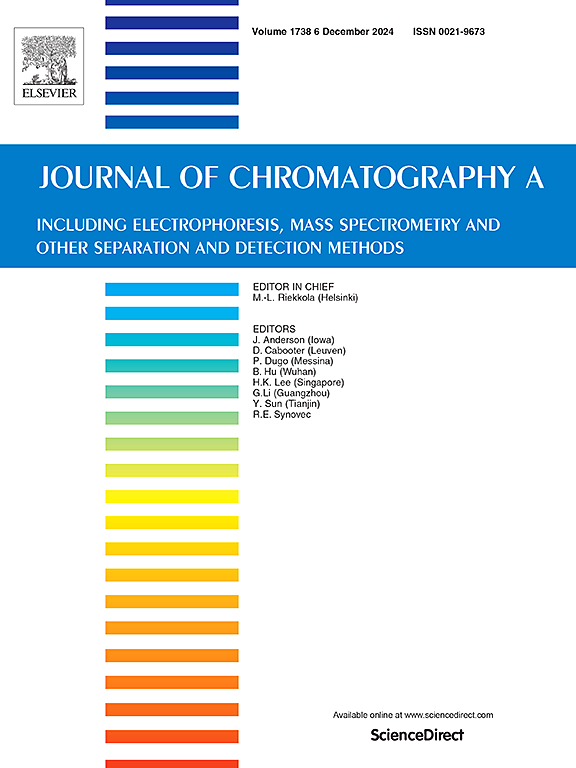Potential of green solvents as mobile phases in liquid chromatography
IF 3.8
2区 化学
Q1 BIOCHEMICAL RESEARCH METHODS
引用次数: 0
Abstract
This review summarizes the key points and focuses on the use of green solvents in reversed-phase high-performance liquid chromatography. Ethanol, acetone, ethyl lactate, propylene carbonate, dimethyl carbonate, methyl acetate, Cyrene, and glycerol are examined as green solvents, with an emphasis on their properties related to HPLC applications. A total of 135 articles published between 1990 and the present, which utilize ethanol-water mobile phases in RP-HPLC, highlight the established use of ethanol as a green solvent for RP-HPLC. Although ethanol is often characterized by its high viscosity and UV absorbance, it remains one of the most commonly used green solvents. This study shows that approximately 30 % of the ethanol-based methods developed employed columns with reduced particle diameters, without the need for column heating. In 26 % of cases, UV detection was used, even at wavelengths egal to or below 220 nm. However, ethanol's volatility and flammability pose risks of operator exposure and fire hazards. Consequently, alternative solvents have been explored to mitigate these issues.
Acetone, with over 20 years of use, presents similar safety concerns, compounded by its high UV absorbance. Recent advances in greener solvents, such as Cyrene, glycerol, and natural deep eutectic solvents, have been investigated to address VOC concerns in HPLC. However, these solvents still face challenges, including UV absorption, immiscibility with water, high viscosity, and limited availability in HPLC-grade quality. Therefore, additional research is needed to facilitate their broader application.

绿色溶剂在液相色谱中作为流动相的潜力
本文综述了绿色溶剂在反相高效液相色谱中的应用。乙醇、丙酮、乳酸乙酯、碳酸丙烯、碳酸二甲酯、乙酸甲酯、昔兰尼和甘油作为绿色溶剂进行了研究,重点研究了它们与高效液相色谱应用相关的性质。从1990年到现在,共发表了135篇利用乙醇-水流动相进行反相高效液相色谱的文章,强调了乙醇作为反相高效液相色谱的绿色溶剂的确定用途。虽然乙醇通常具有高粘度和紫外线吸收性的特点,但它仍然是最常用的绿色溶剂之一。这项研究表明,大约30%的基于乙醇的方法开发采用柱与减少颗粒直径,不需要柱加热。在26%的情况下,使用紫外线检测,即使波长等于或低于220纳米。然而,乙醇的挥发性和可燃性给操作人员带来了暴露和火灾危险的风险。因此,已经探索了替代溶剂来缓解这些问题。使用了20多年的丙酮,由于其高紫外线吸收性,也存在类似的安全问题。绿色溶剂的最新进展,如昔兰尼,甘油和天然深共晶溶剂,已经研究了解决HPLC中挥发性有机化合物的问题。然而,这些溶剂仍然面临挑战,包括紫外线吸收,与水的不混溶,高粘度,以及hplc级质量的有限可用性。因此,需要进一步的研究以促进其更广泛的应用。
本文章由计算机程序翻译,如有差异,请以英文原文为准。
求助全文
约1分钟内获得全文
求助全文
来源期刊

Journal of Chromatography A
化学-分析化学
CiteScore
7.90
自引率
14.60%
发文量
742
审稿时长
45 days
期刊介绍:
The Journal of Chromatography A provides a forum for the publication of original research and critical reviews on all aspects of fundamental and applied separation science. The scope of the journal includes chromatography and related techniques, electromigration techniques (e.g. electrophoresis, electrochromatography), hyphenated and other multi-dimensional techniques, sample preparation, and detection methods such as mass spectrometry. Contributions consist mainly of research papers dealing with the theory of separation methods, instrumental developments and analytical and preparative applications of general interest.
 求助内容:
求助内容: 应助结果提醒方式:
应助结果提醒方式:


